
Original Link: https://www.anandtech.com/show/1849
The Holiday Stop Gap: GeForce 6800 GS
by Derek Wilson on November 7, 2005 9:00 AM EST- Posted in
- GPUs
Introduction
It's about that time again. It's been a few months since NVIDIA introduced something exciting and ATI has been launching (and paper launching) parts left and right. From the GT and GTO (which have been on shelves for a while) to the many X1000 series parts (many of which haven't shown up yet) ATI has not been quiet. And today NVIDIA brings the fight back to their door with another product launch that's available on the day it's announced.
At the same time, this is no X1800 XT killer: NVIDIA is launching its GeForce 6800 GS today.

What we did focus on here is how the new 6800 GS compares to the current NVIDIA lineup. Coming in at a low cost with very good performance, this new 12 pipe part packs quite a punch when it comes to value. Unfortunately, while the part is available right now, it doesn't seem to be supported by that many manufacturers. We also aren't certain how long the 6800 GS will last either. This has all the makings of a holiday gift from NVIDIA that won't last very long.
Is NVIDIA actually offering this new part out of the goodness of its heart? Or does the 6800 GS only get to exist long enough to hedge sales of ATI parts during the holiday season? In the end it really doesn't matter that much: the 6800 GS is a good part no matter how long it sticks around.
The Card, The Test and Power
The 6800 GS cards will all sport NVIDIA's NV42 core. Previously, NV41 and NV42 cores were used on vanilla 6800 boards. The main difference between the two parts is that the NV41 is run on IBM's 130nm process (and was NVIDIA's first native PCIe part), while NV42 uses TSMC's 110nm process. And where there is a process shrink with no other major changes, higher clock speeds are more accessible.
Thus, the 6800 GS is physically the same as a vanilla 6800 with a higher core clock speed (425) and paired with GDDR3 at a 1000MHz data rate. From the 6800 GT, we see a decrease of 25% in pixel pipeline, but a ~21.4% increase in core clock speed. The net result is a theoretical core performance decrease of only 9%, but since NV42 doesn't require a bridge chip the results may be even closer than that. This puts the 6800 GS in the same class as the 6800 GT (but at a much lower cost).
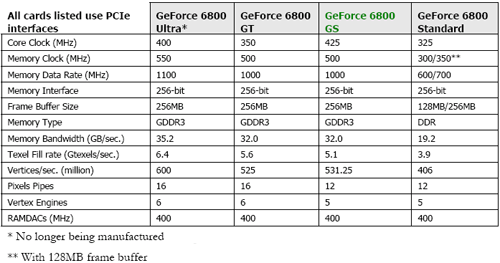
The main reason this card will cost less than the 6800 GT is die size. Being manufactured as a 12 pipe / 110nm chip, NV42 will definitely be smaller and more cost efficient than the chip powering the 6800 GT. As far as we know, 6800 GT still uses the NV45 which features 16 pipes and is manufactured on a 130nm process. Combine this with the fact that NV45 is bridged from AGP to PCIe on package, and there is no question about the cost difference between silicon solutions.
What remains to be seen is how the current market will react. Our initial probes indicate that the 6800 GS will be a very limited offering with its cycle ending in Q1 06. With the potential to perform as well as a 6800 GT for the price of a vanilla 6800, the 6800 GS seems to warrant a longer shelf life than our sources indicate. Either way, the 6800 GS and ATI's X800 GTO parts point to limited run cards with excellent value growing in popularity. As with any good part, we would like to see the products linger a little longer, but the introduction of these late blooming parts is good for consumers in the market for a midrange card no matter why NVIDIA and ATI created them.
For our performance tests, we used this system:
Test Hardware
| CPU: | AMD Athlon 64 FX-55 (2.6GHz) |
| Motherboard: | EPOX NF4 SLI |
| Chipset: | NVIDIA nForce4 SLI |
| Chipset Drivers: | nForce4 6.70 |
| Memory: | OCZ PC3500 DDR 2-2-2-7 |
| Video Card: | ATI Radeon X800 XL ATI Radeon X800 GTO NVIDIA GeForce 6600 GT NVIDIA GeForce 6800 GS NVIDIA GeForce 6800 GT NVIDIA GeForce 7800 GTX |
| Video Drivers: | ATI Catalyst 5.10a NVIDIA ForceWare 81.87 |
| Desktop Resolution: | 1280x960 - 32-bit @ 60Hz |
| OS: | Windows XP Professional SP2 |
We measured power draw at the wall for each card as well. Load was generated by running our Splinter Cell: Chaos Theory benchmark and observing the maximum power draw. The 6800 GS falls somewhere in the middle of the pack in terms of power draw.


Battlefield 2 Performance
With the first of our performance tests, a trend emerges that we might as well get used to early on. The 6800 GS performs almost identically to the 6800 GT. The pipeline and clock speed differences seem to cancel each other out and give the 6800 GS quite a bit of punch for about $100 less than the 6800 GT. Not only this, but the 6800 GS handily beats out the X800 GTO and the X800 XL in this benchmark. With the GTO priced slightly lower and the X800 XL a little higher, the 6800 GS leads not only NVIDIA's own camp, but ATI's as well.
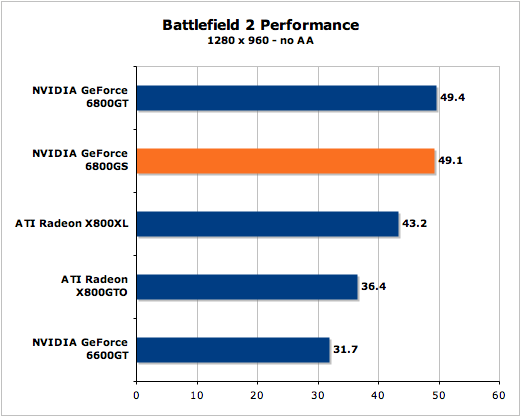
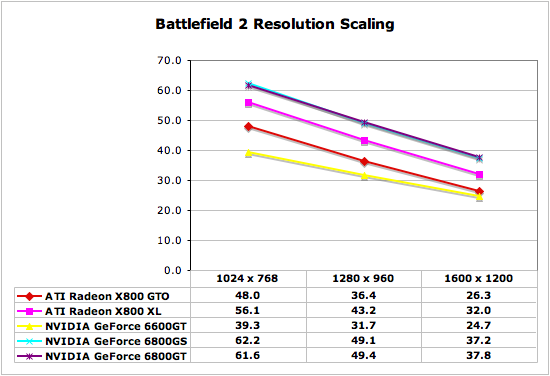
Doom 3 Performance
Doom 3's engine typically favors NVIDIA hardware, and this round of tests falls in line with the rest. Again the 6800 GS performed the same as the 6800 GT, and again both of those cards led the pack in our tests.
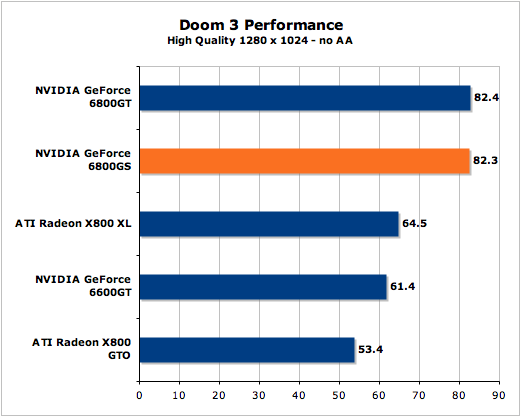
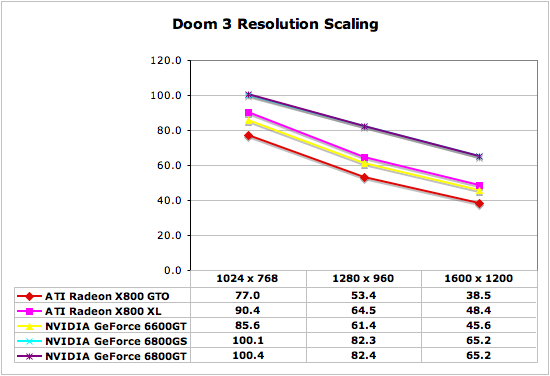
F.E.A.R. Performance
For this test, we ran F.E.A.R. with out soft shadows not only because of the severe performance penalty, but also because we feel the effect just looks bad. The ATI cards don't seem to scale as well with resolution as the NVIDIA cards do, but none of this bunch are really able to run the game smoothly at 1600x1200. The sweet spot for the 6800 GS and GT is 1280x960, but the other cards might be better off running at 1024x768.
Also, while the 6800 GS and GT perform very similarly again, the GT holds a slight edge in this test.
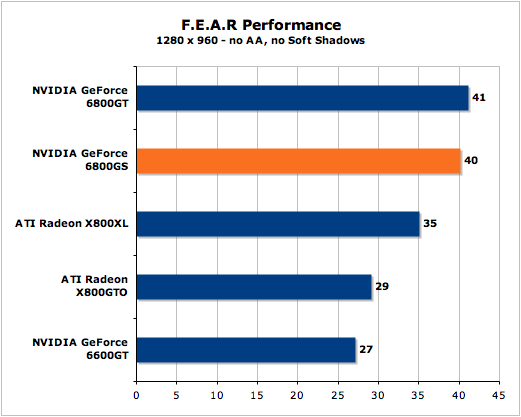

Half-Life 2 Performance
Typically, Half-Life 2 favors ATI hardware. The X800 XL handles this benchmark better than the rest of the cards in the group, but the 6800 cards still manage to hold their own against the X800 GTO and 6600 GT. While this game is a bit CPU limited at lower resolutions, Valve's Source engine is fairly popular and that makes HL2 a worth while test.
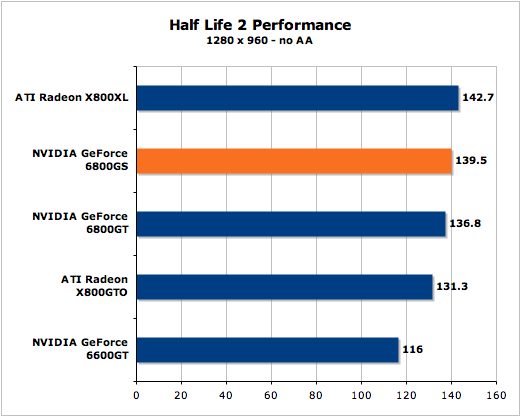
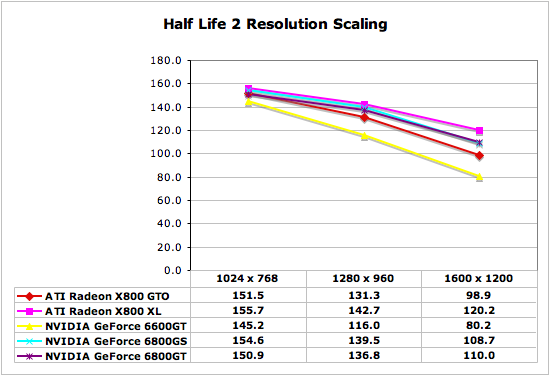
Splinter Cell: Chaos Theory Performance
The X800 XL makes a good showing in this benchmark as it performs just ahead of the 6800 GS and GT. While this would be fine if only competing against the 6800 GT, the X800 XL suffers a disadvantage when competing against the much cheaper 6800 GS.
The X800 GTO also has no hope of competing in terms performance or bang for the buck with the 6800 GS. This benchmark does show that the ATI cards are on the same playing field, but the 6800 GS is just a better value.
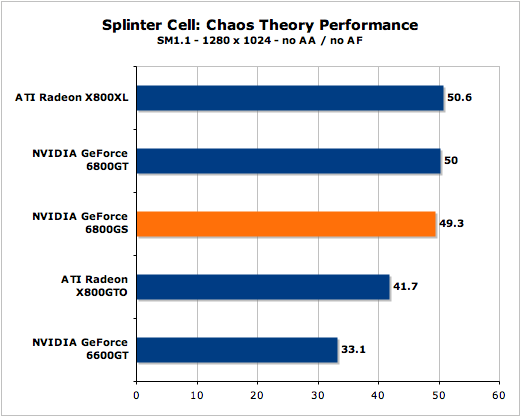

SLI and Antialiasing
SLI can end up nearly doubling performance in some cases. In those cases we will see two 6800 GS cards deliver performance on par with a single 7800 GTX. But much more of the time we will see only a modest performance gain from SLI. Since one 7800 GTX costs about the same as two 6800 GS cards, we have to strongly recommend against going with 6800 GS SLI. If performance is desired and the money is there, the 7800 GTX is the better buy by a long shot.

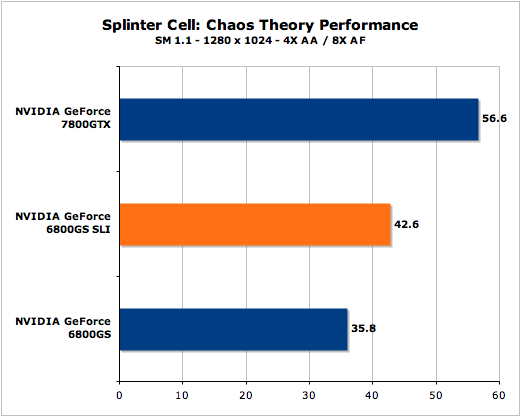
The memory bandwidth of the 6800 GS makes antialiasing possible on most games at 1280x1024 and below. At higher resolutions, AA performance might not be where we would like. Games like Half-Life 2 will certainly run fine on a 6800 GS with AA enabled at 1600x1200. But the SC:CT and BF2 tests we ran show that the 6800 GS just doesn't have what it takes to make 1600x1200 with 4xAA a reality.
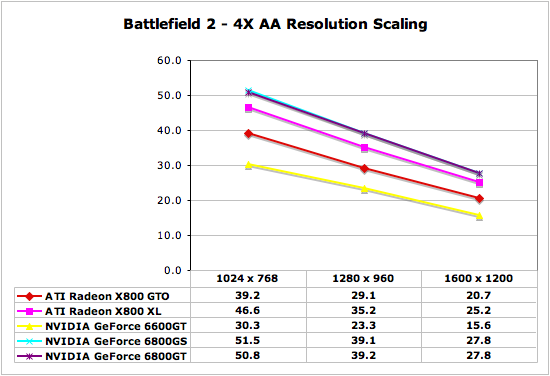
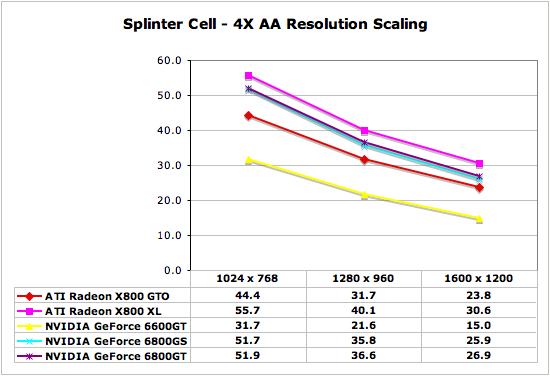
Final Words
The King is Dead! Long Live the King!
For most of its life the 6800 GT was NVIDIA's best high end value. The 6800 Ultra was both too hard to find and too expensive to be worth the investment, while the 6800 GT performed very well and wasn't a bad overclocker either. But ever since the 7800 series came along, the 6800 GT just hasn't been as viable an option. Today we can find cheap 7800 GT parts for about as much as an average 6800 GT (~$320).
Today sees the introduction of a part that performs just as well as the 6800 GT but costs about $70 to $80 less. The 6800 GS looks like it hits the sweet spot between price and performance this holiday season. Aside from cutting the cost of the 6800 GT, the 6800 GS doesn't cost that much more than a vanilla 6800 with 256MB of RAM. As the vanilla 6800 performs just slightly better than the 6600 GT, we can say with confidence that the 6800 GS has taken over the 6800 line and is the only real option left of the bunch.
We had heard that only EVGA would be building the new king of value, and then only until the first quarter of next year. It has come to our attention that most of the usual suspects will eventually come out with 6800 GS parts. With all the advantages the 6800 GS holds over its 6800 series brethren, we are glad to see that it will stick around.
Putting 6800 GS cards together in SLI is not worth it when you can get a 7800 GTX for less than 2x the price. Since the 6800 GS will be a short lived product (from what we understand) SLI as a future upgrade is not a viable option - stick with the single card here or go with something faster if you need to spend more money. We don't like SLI upgrades anyway, but it's even less smart an idea if you can't be sure the card will be around much longer.
This card does for NVIDIA what the X800 GTO did for ATI a short time ago. The X800 GTO falls short in terms of value compared to the 6800 GS, which is both impressive and exactly why NVIDIA wanted to bring it out now. With initial prices on upcoming ATI parts looking to be a little high for their performance, this seals a recommendation for NVIDIA for the holiday season: if you've got about $220 to spend on a graphics card, the 6800 GS is the part to have.
Of course, if you are the adventurous kind and enjoy modding your hardware, the X800 GTO does have something to offer. Most of these cards are easily overclockable and/or flashable to 16 pixel pipelines. The 6800 GS won't allow anyone to unlock extra pipelines as the silicon is built around 12 pixel pipes to save die area. Getting good results with the X800 GTO is not guaranteed, but for those willing to take the risk, the option is there.
All the new parts add a lot of confusion to the mix. With both ATI and NVIDIA bringing out essentially redundant parts, it's hard to know what to recommend or buy. Luckily, NVIDIA has cleared that up for us - the entire rest of the 6800 line is going away and only the 6800 GS will remain. As for ATI, it is very hard to address the amount of spring cleaning their line up needs (especially with the X1000 series parts coming out soon).
You can buy the 6800GS today in its eVGA forum at several vendors.







